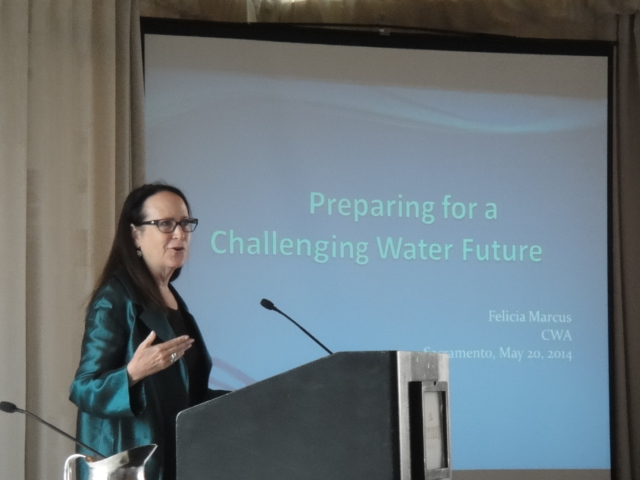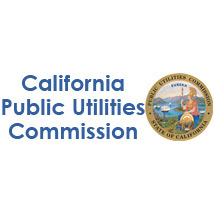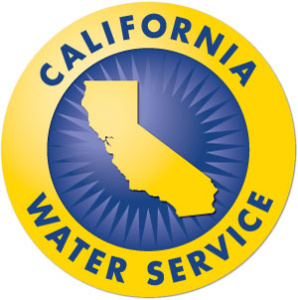Elected and appointed officials in the Legislature and state agencies joined CWA members on May 20 in Sacramento at California Water Association’s (CWA) annual spring conference to explore the many avenues ahead for the state in choosing the path to water security in the years ahead. Working under the conference theme, “Mission Possible: Securing California’s Water Future,” the speakers addressed a myriad of topics, including the water bond legislation, the Governor’s Water Action Plan, how water purveyors are managing the drought, the extraordinary reliance on groundwater during the drought, and the transfer of the state’s Drinking Water Program to the State Water Resources Control Board.
Other topical issues featured at the conference were the latest on the new state regulatory standard for hexavalent chromium, the challenges associated with helping low-income customers with their water bills, and the prominence of water in the 2014 legislative session.
Morning Program
Anthony Rendon (D-South Gate), chair of the Assembly Water, Parks & Wildlife Committee, opened the conference with a personal reminiscence of his journey in becoming the point person in the California Assembly on the ever-contentious water issues in the legislature. He reviewed the months-long statewide meetings with the Assembly’s Water Bond Working Group and their constituents, which resulted in significant revisions to the original 2009 water bond ballot measure, leading up to his Assembly Bill 1331, which had become the lead legislative vehicle for consideration on the fall 2014 ballot.
Felicia Marcus, Chair of the State Water Resources Control Board (State Board), was the featured luncheon speaker, and she covered a wide range of topics, including implementation of Governor Brown’s April 25 Executive Order, which called on state agencies like the State Board to redouble their actions to mitigate the effects of the drought. Board Chair Marcus also gave the audience her perspective of the current efforts to strengthen groundwater management in California, as well as the pending transfer of the Drinking Water Program to the State Board on July 1.
With the current drought well into its third year, water utilities statewide are in the midst of implementing their water shortage contingency plans. Conference Program Chair Larry Morales, Vice President & General Manager of East Pasadena Water Company, moderated a panel on how water purveyors are managing the drought in their service areas. Rami Kahlon, Director of the Division of Water & Audits for the California Public Utilities Commission (CPUC), covered the work of the Governor’s Drought Task Force, of which he has been a member, as well as the CPUC’s own efforts on behalf of the state’s regulated water companies. Of particular note was the CPUC’s February 27 approval of the revised tariff condition, Rule 14.1, and order requiring activation of voluntary conservation plans.

Joining Kahlon and Morales on the panel was Ken Jenkins, Conservation Manager of California Water Service Company, Bob Shaver, Assistant General Manager of Alameda County Water District, and Dana Friehauf, Acting Water Resources Manager of the San Diego County Water Authority. The audience learned first-hand the specific drought conditions under which these three utilities are operating, the particulars of their drought management plans, and their outreach programs to their customers. All are working to comply with Governor Brown’s two emergency proclamations in January and April calling for a statewide voluntary reduction in water consumption of 20 percent by urban water customers.
Kamyar Guivetchi, California Department of Water Resources Manager of Statewide Integrated Water Management, brought the conference attendees up to date on the just-completed California Water Plan Update 2013 and the Governor’s Water Action Plan, released in January 2014. The latter is a five-year effort designed to achieve three broad goals – supply reliability for farms and communities, restoration of important habitat and species, and more resilient and sustainably managed water systems, including supply, water quality, flood protection and ecosystems. He explained how the 10 action items in the Governor’s plan dovetailed with the 30 resource management strategies in the longer-term Water Plan Update.
The state’s reliance on groundwater during the drought has risen – from a normal share of 38 percent of demand to the current share of 60-plus percent – and this increased reliance has prompted interest in new groundwater legislation. Maurice Hall, Director of the California Water program for The Nature Conservancy, and he treated the conference attendees to a tutorial on what effective groundwater management is all about. He indicated that proactive groundwater management is essential to: avoid overdraft; avoid seawater intrusion; protect surface water supplies; protect stream flows for fish; protect drinking water quality; support riparian habitat; facilitate conjunctive use; support groundwater storage; and allow true integrated water management. Hall emphasized the Conservancy’s guiding principle for its water work: “Water Supply for Nature is Most Dependable if Needs of our Communities, Cities and Farms are Stable and Reliable.”
Afternoon Program
Dawn White, Water Quality Manager for Golden State Water Company, and Tarrah Henrie, Manager of Water Quality for California Water Service Company, gave the latest on the new regulation, or Maximum Contaminant Level (MCL), for the incidence of hexavalent chromium (Cr-6) in California’s drinking water. The new MCL, 10 parts per billion, or 10 micrograms per liter (ug/L), goes into effect on July 1, 2014, and affected water utilities are busy now with implementing their compliance programs.
Henrie showed the regions of the state that will be most affected and described the treatment options selected for Cal Water’s Willows District in northern California, which has seven active wells with an average concentration level of 16 ug/L. This district, which serves about 7,000 people, is looking at a capital investment of $8 to $17 million (depending on the number of wells treated; all seven may not be treated immediately) for the Strong Base Anion Exchange treatment option, and annual operating expenses, ranging from $254,000 to $360,000 (again, depending on the number of wells treated). The company has been aggressively seeking ways to reduce the dramatic increases expected on customers’ monthly water bills and is working with the state and the California PUC on ways to mitigate the impact on their customers.
CWA was pleased to have Corine Li, Manager of the Drinking Water Office for Region 9 of the U.S. Environmental Protection Agency (USEPA). She reviewed USEPA’s health risk assessments since 1991 on Cr-6, including the most recent National Toxicology Program studies from 2005-07, noting that physical changes in rats and mice tested through oral exposure began occurring at the 20 ug/L levels. Li also said the most recent peer-reviewed USEPA health risk assessment from 2011 had been withdrawn due to new information received and that it’s not clear when a new assessment will be released. Because USEPA will have to complete a new health risk assessment on Cr-6, she said it will be some time before a national standard for Cr-6 is established.
Helping Low Income Customers Pay Water Bill
In 2014, during the Senate Rules Committee confirmation hearing for CPUC Commissioner Carla Peterman, State Water Board members Doreen D’Adamo, Tam Doduc and Fran Spivey-Weber, Senator Ricardo Lara asked all four of them a series of questions on what the state should do to assist low-income/disadvantaged water customers. Likewise in 2014, Assemblymember Mariko Yamada introduced AB 1434, which would require the Department of Community Services to develop a plan for the funding and implementation of a Low-Income Water Rate Assistance Program that would, among other things, require water service providers in the state to provide discounts or subsidies for eligible low-income residential water ratepayers who enroll in the program.
All of these examples demonstrate that assistance and subsidies for low-income customers is no longer confined to the CPUC and its regulated energy and water utilities, but that this policy is becoming firmly institutionalized in statewide water policy. The question, of course, is to ascertain the best public policy approaches to financing these subsidies, and that was the purpose of a panel moderated CWA Executive Director Jack Hawks.
Panel members Laurel Firestone, Co-Director of the Community Water Center, Katrina Jessoe, Assistant Professor of Agriculture and Resource Economics at the University of California, Davis, Ortensia Lopez, Executive Director of El Concilio of San Mateo County, and Dave Stephenson, Director of Rates for California American Water, all shared their perspectives on how state policy with respect to low-income assistance should evolve. In particular, they explored the ramifications of how these customer subsidies should be financed – by other ratepayers or by the taxpayer.
Water: Front and Center in the 2014 Water Legislative Session
The Spring Conference closed with its traditional panel of legislative experts opining on the prospects of pending water legislation. This year, CWA was honored to have the session open with remarks from Assemblymember Henry Perea (D-Fresno), who has been a leader in water legislation in recent years. He shared his thoughts on how the state is managing the current drought, and how the Legislature is working to mitigate the adverse consequences for those customers and communities most affected by the dry conditions. Assemblymember Perea summarized several of his current bills dealing with these issues, including his water bond bill, AB 2686 (which after the conference, moved to the forefront of the bond legislation being considered).
Meg Catzen-Brown, Senior Policy Advisor at Nossaman LLP, moderated the panel, which consisted of Jennifer Capitolo, CWA’s Legislative Advocate, also of Nossaman LLP; Kathleen Cole, Executive Legislative Representative of the Metropolitan Water District of Southern California; Wendy Ridderbusch, Director of State Relations for the Association of California Water Agencies; and Jennifer West, Director for Water at the California Municipal Utilities Association. Ridderbusch covered the pending groundwater and recently enacted drought assistance legislation, while Capitolo reviewed the budget trailer bills associated with water, especially the legislation on a more realistic timetable for compliance with the new Cr-6 MCL, and Assemblymember Yamada’s AB 1434 dealing with low income customer subsidies.
West explained the legislative details of the Drinking Water Program transfer from the Department of Public Health to the State Water Board, plus the group of water-use efficiency and Urban Water Management Plan bills working their way through the legislative process. Cole reviewed the water bond bills still active, explaining the different allocation amounts between the various bills. She also explained what had to happen legislatively for one of the water bonds to appear on the fall election ballot.
The conference closed with a special celebration for Catzen-Brown, hosted by former State Senator Bill Emmerson, who is now Senior Vice President of the California Hospital Association. Catzen-Brown, who has been CWA’s principal legislative advocate since the beginning of 1988, and who has presided over numerous legislative successes CWA throughout that time, is retiring at the end of 2014.
Presentations can be found at cwacontent.local.





